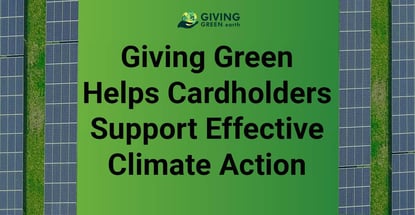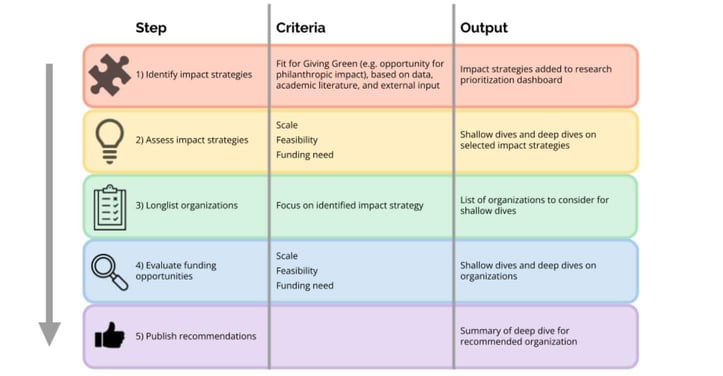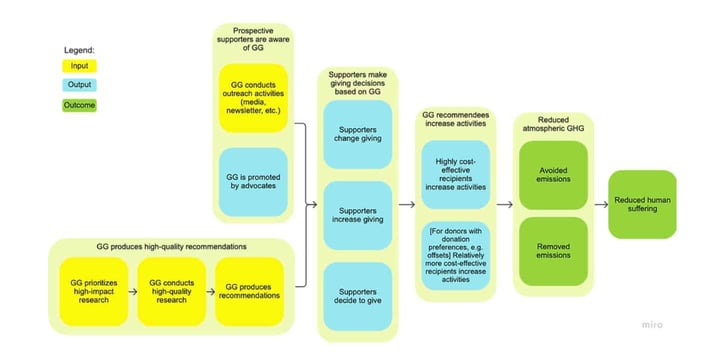
Our experts and industry insiders blog the latest news, studies and current events from inside the credit card industry. Our articles follow strict editorial guidelines.
In a Nutshell: Few public issues are surrounded by more controversy than climate change. The best approach to deciding which climate change mitigation initiatives are the most effective is to follow the evidence. Inspired by the principles of effective altruism, Giving Green recommends highly effective climate initiatives donors can confidently support. Incubated at the global advisory, analytics, and research organization IDinsight, Giving Green welcomes direct support and makes donating to effective climate initiatives easy.
The scientific method is based on falsifiability, meaning new evidence can overturn accepted claims and establish a revised consensus. The public may not be aware of the progression of knowledge which can lead to obsolete ideas attracting misplaced attention and support.
Regarding climate change, political controversy further clouds the picture because opposing sides want to win the debate and push policy in their preferred direction. Most people interested in the field accept that the climate is changing, but understanding why and deciding what, if anything, to do about it are seemingly open questions.
Giving Green is a nonprofit that helps concerned citizens and stakeholders evaluate climate change claims, determine the most impactful strategies to mitigate human-caused effects on climate, and support those initiatives.

The experts at Giving Green apply the evidence-based principles of effective altruism and perform rigorous research to highlight the most effective initiatives. They review their findings and revise recommendations as the evidence changes, always directing the public to initiatives with the best chance to succeed.
Dan Stein is the Founder of Giving Green and Chief Economist for IDinsight, an advisory, analytics, and research organization that helps global development leaders make better decisions. IDinsight houses Giving Green as a nonprofit, and Stein’s team at Giving Green dedicates itself full time to its climate change mission.
Cardholders interested in supporting high-impact climate initiatives may donate to the Giving Green Fund, which regrants resources to top climate nonprofits, or they can choose to support Giving Green’s research. Giving Green’s donation page also provides links enabling donors to contribute to organizations directly.
“We’re motivated by what the evidence says about where the money’s needed,” Stein said. “We look carefully at the research and distill it into a set of strategies and recommendations suitable for the general public.”
Research Based on Scale, Feasibility, and Funding Need
Giving Green focuses on climate change mitigation strategies. It also works on subsets of the field, including Australian climate policy, carbon offsets and removals, and ESG funds and impact investments. The work on climate change mitigation generates the recommendations linked above.
Its research process is highly structured. It starts with the team itemizing the philanthropic landscape and plotting the results on a publicly available research prioritization dashboard.
“We try to think of everything anyone can do to influence the climate,” Stein said.
That leads down some rabbit holes but also identifies many creative strategies, including deploying solar panels in the US, funding protesters to shut down airports, and lobbying the US government to increase nuclear energy funding. The idea is to record it all on a spreadsheet as comprehensively as possible.

The next step is to assess the effectiveness of each strategy according to scale, feasibility, and funding needs. The framework helps the team identify strategies that need funding and attack the most significant climate challenges in ways that seem most likely to succeed.
The detailed work draws on data from the UN’s Intergovernmental Panel on Climate Change, academic and nonacademic research, and funding data, including public, private, and philanthropic spending. The team seeks feedback from climate researchers, philanthropists, policymakers, and other experts.
At the end of the process, there’s a strong consensus within the team that its top recommendations stand the best chance to significantly impact climate change based on the principles of effective altruism.
“We look for initiatives that impact the leverage points within the system,” Stein said. “The organizations that make our final list can make a big difference with some extra funding.”
Impact-Focused Team Continually Revises Data
Change is endemic to the scientific enterprise. Giving Green recognizes that change may impact its recommendations.
Therefore, its research never ends. It subjects its findings to continual review and issues fresh recommendations annually, unlike many nonprofits with a stake in the political process that publish a whitepaper and walk away.
On the research side, a new paper may question a formerly well-regarded strategy or refute its effectiveness. Political and public opinion shifts can lead to changes in funding priorities that may reduce the imperative to recommend some programs and elevate it for others.

Timing is also a factor, with Giving Green considering what Stein called political and corporate moments to determine which sectors are ready to receive a funding boost and run with it.
“We’re a living, breathing, and evolving research team constantly taking on and integrating new information,” Stein said. “When fundamentals change, so do our issue areas and the organizations we recommend.”
The result is that Giving Green becomes an engine for moving money toward high-impact action. The team works closely with the organizations it recommends to track performance and uses that information to inform the next iteration of its recommendations using effective altruism’s impact-multiplier methodology.
It accomplishes that through a tracking system determining how much money it influences compared to its costs. It’s complex because many donors contribute directly to the initiatives rather than through Giving Green.
However, donors may rest assured that Giving Green rests its legitimacy as a provider of actionable climate change recommendations on the veracity of its claims. It even publishes a list of its mistakes.
“We’re only useful as an impact multiplier if we have huge leverage ourselves,” Stein said. “Currently, we have something like an 11x leverage, which means for every dollar we’ve spent, we’ve influenced $11 to our recommended organizations. We think that’s pretty good.”
Giving Green Fund Regrants Support to Top Nonprofits
The Giving Green Fund resides at Giving What We Can, which bills itself as a resource hub for people who want to make a difference. Clicking on this link sets up a donation where you can support both Giving Green’s regranting apparatus as well as supporting Giving Green’s operations.
“We’ve made sure that the organizations we recommend are doing good work and can do a lot with the money they receive from us,” Stein said. “People can also donate directly to the organizations that inspire them. From our perspective, that’s just as good.”

Stein said Giving Green’s most recent recommendations focus on a few categories. One is clean power. Advances in renewables have taken some of the pressure off the power grid, but renewables have problems with intermittency that render them suboptimal in some use cases. Stein said nuclear and geothermal energy are two technologies with the potential to play a significant role in the next-generation power grid.
“Advanced Nuclear technology promises to decreases costs by making the system more modular, and next-generation geothermal can integrate repurposed technologies from fracking to drill for heat,” Stein said.
Opportunities also exist to make industrial processes like steel and cement production more efficient, reduce methane emissions in agriculture, and develop alternative fuel sources for heavy transport.
“About 8% of global emissions come from concrete production,” Stein said. “Also, there are no clean jets or ships, so we recommend looking toward the future to try to solve those problems.”
Those are firm conclusions cardholders can use to base their climate change donation strategies and feel they’re doing the most with their money. Donors may expect Giving Green to stay vigilant as new information materializes.
“We keep our ears to the ground to find those fast-moving, high-impact opportunities,” Stein said.







![8 Best Credit Cards for Restaurants ([updated_month_year]) 8 Best Credit Cards for Restaurants ([updated_month_year])](https://www.cardrates.com/images/uploads/2016/10/CR-Pattern-Blue2.jpg?width=158&height=120&fit=crop)
![7+ Best “2% Cash Back” Credit Cards ([updated_month_year]) 7+ Best “2% Cash Back” Credit Cards ([updated_month_year])](https://www.cardrates.com/images/uploads/2017/02/2-percent.png?width=158&height=120&fit=crop)
